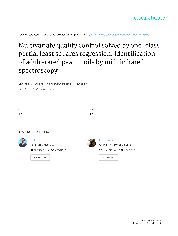摘要
The Partial least squares class model (PLSCM) was recently proposed for multivariate quality control based on a partial least squares (PLS) regression procedure. This paper presents a case study of quality control of peanut oils based on mid-infrared (MIR) spectroscopy and class models, focusing mainly on the following aspects: (i) to explain the meanings of PLSCM components and make comparisons between PLSCM and soft independent modeling of class analogy (SIMCA); (ii) to correct the estimation of the original PLSCM confidence interval by considering a nonzero intercept term for center estimation; (iii) to investigate the potential of MIR spectroscopy combined with class models for identifying peanut oils with low doping concentrations of other edible oils.
It is demonstrated that PLSCM is actually different from the ordinary PLS procedure, but it estimates the class center and class dispersion in the framework of a latent variable projection model. While SIMCA projects the original variables onto a few dimensions explaining most of the data variances, PLSCM components consider simultaneously the explained variances and the compactness of samples belonging to the same class. The analysis results indicate PLSCM is an intuitive and easy-to-use tool to tackle one-class problems and has comparable performance with SIMCA. The advantages of PLSCM might be attributed to the great success and well-established foundations of PLS. For PLSCM, the optimization of model complexity and estimation of decision region can be performed as in multivariate calibration routines.
